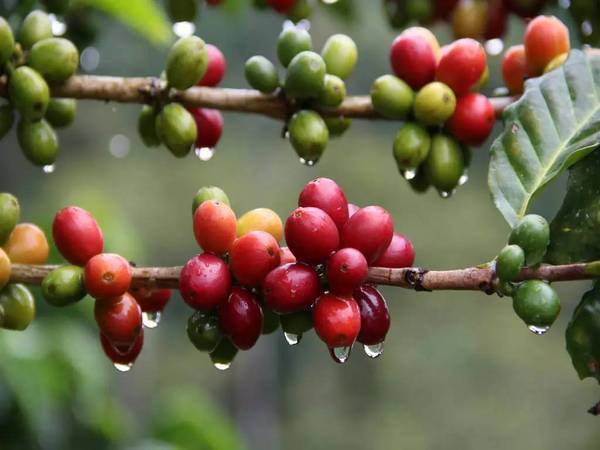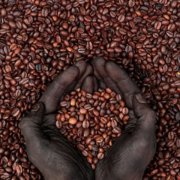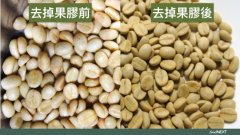Kopi Luwak was defeated. Geisha coffee is the most expensive coffee in the world.

For professional baristas, please follow the coffee workshop (Wechat official account cafe_style)
Panamanian coffee
Panamanian jade villa gardening prostitute (Hacienda La Esmeralda Geisha) coffee comes from a wild species in Ethiopia and grows at 1700 meters above sea level. Its dry fragrance is floral, citrus, berry, honey; wet fragrance is berry, floral, grease, vanilla, citrus; sipping is sour and meticulous, and it has sweet juice, good cleanliness, floral, honey, citrus, berry, slightly tea, cherry, delicate finish and long-lasting aroma. Because of its unique fruit flavor, the international examiner of the auction gave full marks and won more than a dozen different coffee competitions. the auction price repeatedly hit record highs, setting a high price of US $130,130 per pound, and has now beat Kopi Luwak to become the most expensive coffee in the world.
St. Helena Coffee, British Virgin Islands
St. Helena Coffee dates back to 1733 when it was brought into seed cultivation by the British East India Company. When Napoleon was banished to the island after defeat, he praised St. Helena Coffee and even before he died, he wanted to taste it again, making its reputation immortal.
Due to its remote location, the island retains an unpolluted ecological environment, and volcanic geology also provides fertile soil, coupled with organic cultivation, making St. Helena Coffee unique.
Blue Mountain Coffee (Blue mountain)
Jamaica's Blue Mountain is the highest mountain in the Western Caribbean, produced in the Blue Mountains, with slightly sour, supple with sweet, pure Blue Mountain coffee taste, light flavor, but mellow and delicate. The export of Jamaican coffee is subject to the control of the Jamaica Coffee Industry Authority (CIB; established in 1953), which is more stringent and must be grown in areas specified by law and processed in specific refineries before it can be called Blue Mountain Coffee.
In 1969, when the production of Blue Mountain Coffee in Jamaica was affected by a hurricane and its production was in trouble, UCC enterprises in Japan provided assistance to introduce ecological cultivation methods. In gratitude for the assistance of Japanese companies, Jamaica signed a contract with Japan in 1972 to provide 90% of its annual output to the Japanese market, while the remaining 10% was released for sale in the market.
Mocha coffee (Mocha)
The now closed port of Mocha was the main export port of Yemeni coffee in the early days, so Yemeni coffee is called mocha coffee. This kind of coffee is the best produced in Yemen, followed by Ethiopia (located in the southwest of Yemen). Mocha coffee is a very characteristic coffee with strong acid in lubrication, excellent sweetness, unique flavor and chocolate flavor.
Guatemalan coffee
Guatemala Incht Manor (El Injerto) coffee is a mixture of bourbon and other varieties grown in the Vivi Plateau, washed and fermented in the sun, planted at 1500 ∼ 2000 meters, low temperature, slow growth, excellent micro-climate and natural conditions, so it has won numerous awards and has won at least four consecutive Cupof Excellence;CoE Cup championships.
Kenyan Coffee (Kenya AA)
Kenyan coffee is a typical coffee cultivated in the highlands. Kenya sprayed "AA" on the coffee bag, plus a number, indicating that the grade AA is the highest among the ten grades of the quality test cup. Kenyan beans are strictly graded. Coffee beans taken out by the washing plant are divided into seven grades according to size, shape and hardness, the highest is AA or AA+, followed by AB, PB, C, E, TT, T.
Colombian Coffee (Colombia)
Colombia's coffee production ranks second in the world, among which Bucamanga Super Coffee (Bucaramanga Supremo) is the most characteristic, with soft and mellow flavor, slightly sour to medium acidity, stable quality and flavor, and is the top grade of mixed coffee. On the streets of Colombia, hand-pushed coffee sellers are common, which is a very special street scene.
Brazilian Coffee (Santos)
Brazil is the world's largest coffee producer, the coffee produced, mild flavor, slightly sour, slightly bitter, as the representative of neutral coffee, is an indispensable variety of mild coffee. With the drought in recent years, the output of coffee beans has also decreased sharply.
Brazil's Fazenda Santa In ê s has natural spring water, well-preserved primeval forests and growing bourbon coffee, covering an area of 214ha and only 105ha, where there is a large temperature difference, no frost damage, fertile volcanic soil, manual picking and harvesting half-sun treatment (pulped natura lprocess), which once set a high bidding price of US $49.75USD / lb by CoE, a record that has only been broken in recent years.
Hawaiian Kona Coffee (Kona Fancy)
Kona coffee is grown in the volcanic area of the western part of Hawaii, the largest island of Hawaii, which is the only place in the United States where coffee is produced. The beans are of stable quality, strong in taste, strong in acid, rich in flavor and special in flavor.
Although Hawaii is often hit by tornadoes, the local climate is very good for coffee growing. there is not only plenty of rain and sunshine, but also no frost, and on most days, around 2 p.m., clouds appear in the sky to provide the necessary shade for coffee trees.
In 1996, a producer disguised cheap beans from Central America as Cona beans. After this incident, people began to face up to the traceability of production resumes so as not to fake them.
Carbonated coffee (Charcoal fire)
Charcoal coffee, also known as bitter coffee, is a coffee bean produced in Guatemala. Guatemala's planting conditions are quite unique, no matter the altitude or soil, climate are very suitable for the growth of coffee trees, the beans produced by the complex and delicate flavor, is the famous volcanic area coffee.
Charcoal roasted coffee is not deep-roasted coffee beans, but shallow-roasted coffee beans, roasted beans from the same source of fire as in Japan, using carbon fire, and sometimes using special wood as fuel to increase flavor. Coffee beans roasted with carbon fire in this way have a woody flavor rather than a carbon-roasted flavor.
Manning Coffee (Mandheling)
Mantening coffee is the most representative coffee from Sumatra, Indonesia. It has a strong taste, but it is supple, acid-free, fragrant, strong and bitter. It is the best coffee produced in Indonesia.
Around 1945, Japanese soldiers stationed in Indonesia drank a very good coffee on the island of Sumatra and asked the vendor the name of the coffee. The vendor mistakenly thought he was from, so he replied, "I am Mandailing." "the lack of language led to this beautiful misunderstanding. Japanese soldiers thought that the name of coffee was" Mandheling ". From then on, Mantenin became synonymous with coffee in Sumatra, and later, because Mantenin was so famous that any coffee produced in Indonesia's Jiangsu Province was called Mantenin.
Animal coffee
Some animals will eat coffee berries, because the coffee beans cannot be digested, so when the berries are digested and fermented in the animals, the indigestible coffee beans will be excreted from the body, and the locals will pick up the feces discharged by these animals. after being fully washed and roasted, it becomes animal-made coffee. Common species include civet, Vietnamese mink, Taiwan masked palm civet and elephant dung coffee from Thailand.
Important Notice :
前街咖啡 FrontStreet Coffee has moved to new addredd:
FrontStreet Coffee Address: 315,Donghua East Road,GuangZhou
Tel:020 38364473
- Prev

Are you sure you know what kind of coffee you're making? Direct trade in raw coffee beans
Professional barista communication Please follow the coffee workshop (official Wechat account cafe_style) went to Taichung a few days ago to visit the seniors of direct trade. Is it direct trade or fair trade? It doesn't matter, what matters is the truth we see and the process of solving the problem. Direct trade means to enter the producing area and build rural areas "directly" with the standard and spirit of fair trade.
- Next

How much are you willing to pay for this cup of coffee during the whole process of manual processing of raw coffee beans?
Communication of professional baristas Please follow the Coffee Workshop (official Wechat account cafe_style) Writing = Huang Yiling I once did a crazy experiment in which a relative of a neighbor grew coffee in Nantou water, so he gave me a bag of coffee beans. I was actually a little dumbfounded when I received it. I didn't quite know what to do with the bag of coffee beans, and I looked up a lot of data on the Internet for this. I got it.
Related
- Detailed explanation of the proportion of gold gouache in hand-brewed coffee? What are the Gold Cup Guidelines?
- What is the difference between the gold label rose summer and the red label rose summer in Guixia Village? Are Rose Summer 1931 and Gori Rose Summer?
- Cudi stores ban other brands of coffee?! Netizen: No problem
- Is it better to make coffee cold or hot? Why is it recommended to drink hot coffee?
- Lucky people collapsed! The store ceiling is full of AI surveillance cameras?!
- Law Enforcement Bureau? Mixue Ice City enters Zhengzhou BRT platform!
- Heavy! Nestlé has been exposed to consider selling blue bottle coffee!
- Compensation of 270 million yuan! Starbucks has been charged with violating labor laws more than 500,000 times!
- What are Xizhao coffee beans? Why did they become champion beans? How to rush to the manor on the dividing line in Colombia?
- What does channel effect mean in coffee? Why are there holes in the coffee powder cake?

